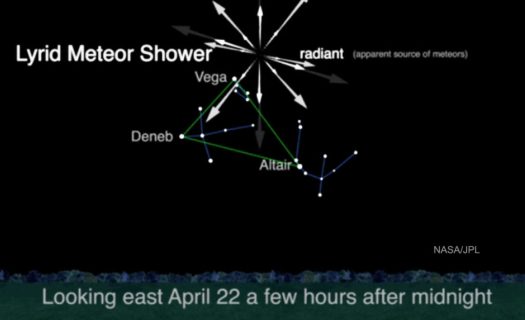
For viewers in the Northern Hemisphere, the early morning hours of Sunday, April 22, will be the best viewing time for the 2017 presentation of the Lyrid meteor shower. From mid-April this year to about April 25 the “shooting stars” are visible with as many as a dozen or so per hour. However, on Sunday morning there will probably be up to 20 per hour.
The Lyrid meteor shower comes around every year in April. There are ten significant meteor showers each year, but the last one was the Quadrantid meteors in early January. Now, at last, with the weather a little warmer we have another chance to watch the sky.
The Lyrid meteor shower gets its name from the fact that it seems to radiate from the constellation Lyra, the harp. No, they are not “shooting stars.” The Lyrid meteors are actually fragments broken off from Comet Thatcher which passed by in 1861. That comet makes a pass through our solar system every 415 years or so.
The Comet Thatcher has been passing through and leaving bits behind for a long time because Chinese sky watchers saw the Lyrid meteor shower in 687 B.C. Apparently they were impressed because they recorded that “stars fell like rain.”
Of course, the ancient Chinese didn’t know what caused the event. We know that it’s the result of those comet pieces falling into our atmosphere, being heated by the friction of the air, and burning up. Our atmosphere does more than just give us oxygen to breathe. It also protects us in many ways. One of those protections is that it causes most objects falling from space to burn up before they reach Earth’s surface. That friction requires heat-shield protection for returning Astronauts, but those of us living on the Earth’s surface can be glad to have an atmosphere to protect us. Recently a Chinese space station the size of a bus fell into our atmosphere and disintegrated before reaching the ground. You don’t need a telescope to see the pockmarks on the Moon’s surface from asteroid impacts because the Moon has no atmosphere.
Speaking of the Moon, it will be in its first-quarter phase and will not set until about 2 A.M Sunday morning. For that reason, viewing the Lyrid meteor shower will probably be best between 2 A.M. and the first light of dawn. However, if you miss it then, you still have a few more days, but the meteors will be fewer and farther between. If you see the Lyrid meteor shower, let it be a reminder of the fact that God has designed a planet that provides for our needs and protects us while we enjoy its beauty.
–Roland Earnst © 2018









